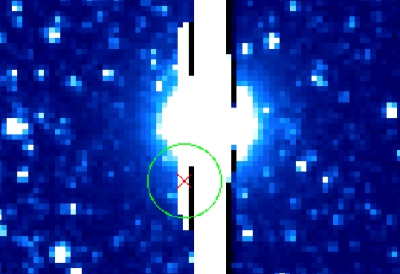INTEGRAL OMC Catches A GRB
8 July 2005
Before June 26 no Gamma-Ray Burst (GRB) had been been observed in the field of view of the Optical Monitoring Camera (OMC) onboard INTEGRAL. Despite over two and half years in orbit this result is not too surprising given the much field of view of the OMC is just 5° by 5° (0.06 % of the whole sky)An automatic system, in place since launch, makes a triggered observation with the OMC based on coordinates provided by the INTEGRAL Burst Alert System. IBAS is a system for the real time detection of the GRB seen by the INTEGRAL satellite and the rapid distribution of their coordinates. IBAS runs automatically at the INTEGRAL Science Data Centre (ISDC), where the satellite data are received with a delay of only a few seconds.
Alerts with the coordinates of the GRBs detected in the field of view of the INTEGRAL imager instrument are distributed by IBAS via internet and can be received by any interested user. These localizations have a typical uncertainty radius of 3 arcmin and are available a few tens of seconds after the GRB start. The current rate of GRBs localization is about 1 per month.
Last Sunday a GRB triggered IBAS and an OMC observation was started just 1m 48s after the GRB brightened. Unfortunately this GRB occurred only a couple of arc minutes away from one of the brightest stars in the sky: Alpha Crucis; a magnitude 0.8 star and the 13th brightest in the night sky. The region where the GRB took place is severely affected by saturation by this very bright star.
 |
|
Credits: J. Miguel Mas-Hesse (LAEFF) and OMC-team |
The chance of such an event occurring so close to such a bright star (Alpha Crucis is the 13th brightest star in the sky) is very small and means INTEGRAL scientists will have to wait a little longer before catching a GRB in the OMC.
